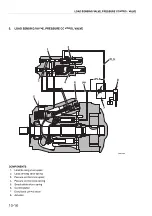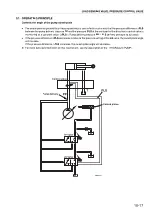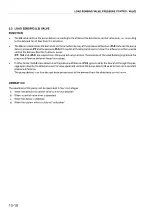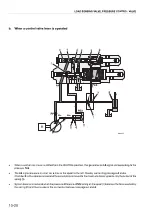
10-19
a.
When the directional control valve is in «NEUTRAL»
·
The pressure
PLS
of the
LS
from the control valve outlet enters the chamber
a
of the
LS
valve spring; the pump de-
livery pressure PP enters the chamber
b
on the opposite side of the spool.
·
The position of the spool (1) is determined by the combination of the force created by the pressure
PLS
plus the force
exerted by the spring (2) and by the force exerted in the opposite direction by the pressure
PP
.
·
Before the engine is started, the control piston (6) is pushed by the spring (5) to the right (corresponding to the max-
imum swash plate angle).
·
When the engine is started, all the control valve spools are in «NEUTRAL», the pressure
PLS
of the
LS
signal remains
at 0 bar (0 psi) as no fluid is delivered from the control valve outlets and the signal is connected to drain.
At the same, the pump delivery pressure
PP
increases as there is no demand from the users.
When the force exerted by the pressure
PP
in chamber
b
balances the force exerted by the spring (2), the spool (1)
moves to the right and allows the fluid at pressure
PP
to flow into the chamber
X
of the piston (6) by connecting pas-
sages
c
and
d
.
·
The force exerted by the fluid pressure on the piston (6) overcomes the force of the spring (5). The control piston is
thus pushed to the left, i.e. towards the minimum swash plate angle position.
·
The pump delivery pressure
PP
stabilizes around the value of 18 bar (261 psi), which corresponds to the standby
pressure.
M
Min
Max
D0000460
8
7
6
5
2
1
PLS
T
PEN
PP
X
b
PP
a
c
d
e
LOAD SENSING VALVE, PRESSURE CONTROL VALVE

















